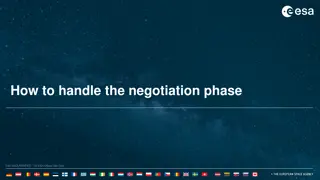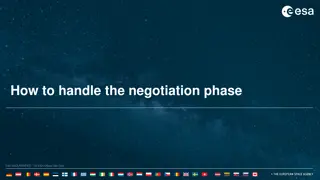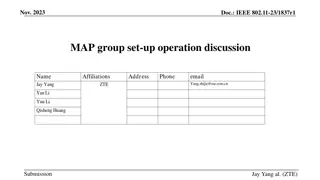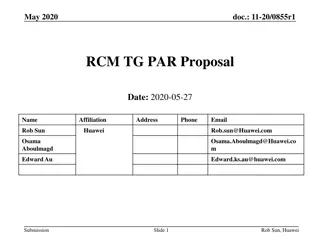IEEE 802.11-20/1044r2 TID-to-Link Negotiation Proposal
Proposal for a simple mechanism to negotiate TID-to-Link mapping between an Access Point MLD and a non-AP MLD to aid in traffic separation, latency-sensitive flow management, and overall channel access optimization. The negotiation process involves consideration of traffic profiles, load balancing, and system-level benefits, promoting efficient mapping decisions for improved network performance.
Download Presentation

Please find below an Image/Link to download the presentation.
The content on the website is provided AS IS for your information and personal use only. It may not be sold, licensed, or shared on other websites without obtaining consent from the author.If you encounter any issues during the download, it is possible that the publisher has removed the file from their server.
You are allowed to download the files provided on this website for personal or commercial use, subject to the condition that they are used lawfully. All files are the property of their respective owners.
The content on the website is provided AS IS for your information and personal use only. It may not be sold, licensed, or shared on other websites without obtaining consent from the author.
E N D
Presentation Transcript
November 2020 doc.: IEEE 802.11-20/1044r2 MLO: TID-to-link negotiation Date: 2020-02-26 Name Affiliation Address Phone Email Abhishek Patil appatil@qti.qualcomm.com Duncan Ho Qualcomm Inc. George Cherian Alfred Asterjadhi Yanjun Sun Submission Abhishek P (Qualcomm), et. al., Slide 1
November 2020 doc.: IEEE 802.11-20/1044r2 Background MLDa TIDbe TIDvo TID-to-link feature maps a TID to one or more links The frames belonging to the TID are sent on the mapped link(s) Such traffic separation can aid latency sensitive traffic flow Assign a high-volume, latency tolerant traffic flow to a subset of link while mapping latency sensitive flows to all links Increases channel access opportunities for a latency sensitive flow At a system level, reduces contention between latency sensitive and latency tolerant flows STAa 1 STAa 3 STAa 2 Link 1 Link 3 Link 2 STAb 3 STAb 2 STAb 1 Other use cases include load balancing, co- ex conditions, separating UL/DL flows etc MLDb Submission Slide 2 Abhishek P (Qualcomm), et. al.,
November 2020 doc.: IEEE 802.11-20/1044r2 Motivation In this contribution, we propose a simple mechanism to negotiate a TID-to-Link mapping between an AP MLD and a non-AP MLD. Submission Slide 3 Abhishek P (Qualcomm), et. al.,
November 2020 doc.: IEEE 802.11-20/1044r2 TID-to-link mapping negotiation By default, all TIDs map to all setup links Also applies when no explicit TID-to-link mapping is negotiated It is optional for an MLD to support TID-to-link mapping negotiation When TID-to-link mapping is supported by both MLDs, the AP MLD can initiate a TID-to-link mapping negotiation AP MLD considers non-AP MLD s capabilities such as MLSR E.g., in case of MLSR, all TIDs are mapped to all setup links AP MLD has the global view and considers BSS-wide conditions such as traffic profiles (e.g., latency sensitive flows) and load on each link to make mapping decisions for each STA All clients are expected to benefit from such mapping A non-AP MLD is recommended to accept AP s proposal A non-AP MLD provides its capabilities and constraints during ML Setup phase A non-AP MLD can suggest its desired mapping for the AP MLD to consider A non-AP MLD can teardown the negotiated mapping if local conditions change Submission Slide 4 Abhishek P (Qualcomm), et. al.,
November 2020 doc.: IEEE 802.11-20/1044r2 Summary In summary we propose a simplified TID-to-link mapping negotiation scheme where: A non-AP MLD can suggest its preferred TID-to-link mapping An AP MLD considers TID-to-link mapping suggested by the non- AP MLDs, traffic profiles and constraints of non-AP MLDs An AP MLD initiates a TID-to-link mapping for the links that are setup between the MLDs The mechanism fits well with existing and upcoming features Blends well with existing power-save schemes, link setup/teardown procedures etc Including proposals on BU indication for each TID Submission Slide 5 Abhishek P (Qualcomm), et. al.,
November 2020 doc.: IEEE 802.11-20/1044r2 SP #1 Do you agree in R1: An MLD may initiate a TID-to-link mapping negotiation with an associated MLD that supports TID-to-link mapping by sending an individually addressed request frame The proposed TID-to-link mapping is established if the responding MLD responds with a response frame indicating ACCEPT A multi-link multi-radio (MLMR) non-AP MLD should accept AP MLD s proposed TID-to-link mapping by responding with an individually addressed response frame indicating ACCEPT An MLD may suggest a TID-to-link mapping by transmitting an individually addressed frame indicating SUGGEST An MLD may teardown a negotiated TID-to-link mapping by sending an individually addressed teardown frame Submission Slide 6 Abhishek P (Qualcomm), et. al.,





















































































